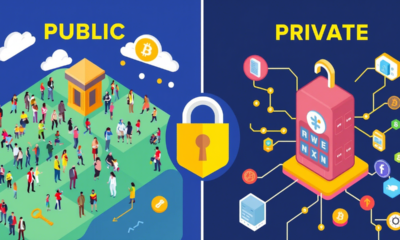Web3 & Metaverse
What Is Web3 and How Does It Differ from Web2?

|
Getting your Trinity Audio player ready...
|

What Is Web3 and How Does It Differ from Web2? – A Technical Deep Dive
In recent years, you may have come across the term “Web3” turning up in conversations, social media feeds, and news articles. But what is Web3 and how does it differ from Web2? Understanding these distinctions is crucial for anyone engaging with the digital landscape of today and the future. In this comprehensive article, we’ll explore the evolution of the internet, the core features of Web3, and how it fundamentally shifts the way we interact online.
The Evolution of the Internet
Web1: The Read-Only Era (1990s-early 2000s)
Before diving into Web2 and Web3, it’s worth acknowledging Web1, the original iteration of the internet. Characterized by static HTML pages, minimal interactivity, and a clear distinction between content creators (webmasters) and consumers, Web1 served primarily as an information repository. Users consumed information passively with limited ability to contribute content.
What Is Web2?
To comprehend Web3, it’s essential first to understand its predecessor, Web2. This term refers to the second generation of the internet—an era defined by user-generated content, social networking, and interactive applications. Here are some key characteristics of Web2:
Centralization
Major corporations such as Facebook, Google, and Amazon dominate content creation and data storage. These platforms utilize client-server architecture, where users interact with applications through centralized servers that store all data and business logic.
Technical Implementation
- AJAX (Asynchronous JavaScript and XML): Enabled dynamic content updates without page reloads
- REST APIs: Standardized methods for server communication
- Cloud Computing: Centralized data centers that power Web2 applications
- Relational Databases: Structured data storage systems managed by service providers
User Engagement
Users are not just consumers; they actively participate by creating content, commenting, and sharing. Think of blogs, social media posts, and forums. This shift gave rise to the term “prosumer” (producer-consumer).
Data Ownership
While users create vast amounts of data, they typically do not own it. Instead, tech giants harvest this data to monetize through advertising. The technical term for this model is “data extractivism” – where user data becomes the primary commodity.
Authentication Mechanisms
Web2 relies heavily on username/password combinations, OAuth, and centralized identity providers. This creates single points of failure and vulnerability for mass data breaches.
The Implications of Web2
Web2 opened up the internet for millions, allowing for creativity and communication like never before. However, this model has drawbacks, particularly related to privacy, data ownership, and centralized control. Users often feel like products rather than contributors, as corporations continue to leverage their information for profit.
Technical Limitations
- Vendor Lock-In: Proprietary APIs create walled gardens
- Single Points of Failure: Centralized architectures are vulnerable to outages
- Data Silos: Information remains isolated across different platforms
- Trust Dependencies: Users must trust companies to handle their data ethically
What Is Web3?
Now, let’s explore what is Web3. Web3 is often described as the third generation of the internet, characterized by decentralized applications and a focus on user privacy and control. The shift towards this new paradigm is fueled by technologies like blockchain, cryptocurrency, and decentralized finance (DeFi).
Foundational Technical Components
Blockchain Technology
At its core, Web3 relies on distributed ledger technology – specifically blockchains. A blockchain is a cryptographically secured, append-only database that is maintained by a network of computers (nodes) rather than a central authority. Key blockchain components include:
- Consensus Mechanisms: Methods by which network participants agree on the state of the blockchain
- Proof of Work (PoW): Used by Bitcoin, requires solving complex mathematical puzzles
- Proof of Stake (PoS): Used by Ethereum 2.0, validators stake cryptocurrency as collateral
- Delegated Proof of Stake (DPoS): Used by EOS, community-elected validators
- Practical Byzantine Fault Tolerance (PBFT): Used by Hyperledger, achieves consensus through voting
- Cryptographic Primitives:
- Public-key Cryptography: Enables secure transactions between parties without prior relationship
- Hash Functions: One-way mathematical functions that ensure data integrity
- Zero-Knowledge Proofs: Allow verification without revealing underlying information
- Merkle Trees: Efficient data structures for verifying large datasets
Web3 Protocol Stack
Web3 implements a multi-layered protocol stack:
- Settlement Layer: The underlying blockchain (Ethereum, Solana, etc.)
- Asset Layer: Tokens, NFTs, and other digital assets
- Protocol Layer: Standards for interaction (ERC-20, ERC-721)
- Application Layer: User-facing dApps and services
- Aggregation Layer: Tools that combine multiple protocols (DeFi aggregators)
Fundamental Aspects of Web3
Decentralization
Unlike its predecessor, Web3 aims to eliminate the power of central authorities. The use of blockchain technology allows for decentralized networks where data is distributed across users rather than being controlled by a single entity.
Technical Implementation:
- Peer-to-Peer Networks: Direct communication between users without intermediaries
- Distributed Storage Solutions: IPFS (InterPlanetary File System), Filecoin, Arweave
- Decentralized Computation: Ethereum Virtual Machine (EVM), WebAssembly (WASM)
User Ownership and Control
In Web3, users regain ownership of their data. The decentralized nature allows users to manage their identities and personal information directly, reducing the risks associated with data theft and misuse.
Technical Implementation:
- Self-Sovereign Identity (SSI): Users control their digital identities through:
- Decentralized Identifiers (DIDs): Globally unique identifiers not dependent on centralized registries
- Verifiable Credentials: Cryptographically secure attestations about identity attributes
- W3C Standards: DID and Verifiable Credentials specifications
Interoperability
Web3 applications can communicate with one another seamlessly. This interoperability enables users to navigate across different platforms without barriers, enhancing the overall user experience.
Technical Implementation:
- Cross-Chain Communication Protocols:
- Polkadot Parachains: Specialized blockchains that can transfer messages and value
- Cosmos Inter-Blockchain Communication (IBC): Protocol for secure data transfer between chains
- Chainlink CCIP (Cross-Chain Interoperability Protocol): Enables messaging and token movements
- Token Standards:
- ERC-20: Fungible token standard
- ERC-721: Non-fungible token standard
- ERC-1155: Multi-token standard supporting both fungible and non-fungible assets
Empowerment through Smart Contracts
Smart contracts automate processes on the blockchain, removing the need for intermediaries. This technology allows for trustless transactions and agreements, streamlining processes across industries.
Technical Implementation:
- Smart Contract Languages:
- Solidity: The primary language for Ethereum
- Rust: Used by Solana, Near, and others
- Move: Used by Aptos and Sui
- Execution Environments:
- Ethereum Virtual Machine (EVM): Turing-complete virtual machine
- WebAssembly (WASM): Used by Polkadot, NEAR, and others
- Formal Verification: Mathematical methods to prove contract correctness
- K Framework: Formal specification language
- Certora Prover: Automated verification tool
Technical Comparisons: Web3 vs. Web2
1. Architecture
Web2:
- Client-Server model
- Centralized databases (SQL, NoSQL)
- Monolithic or microservice architectures
Web3:
- Peer-to-peer networks
- Distributed ledgers
- Protocol-based architectures
- State channels for off-chain scalability
- Layer 2 solutions (Optimistic rollups, ZK-rollups)
2. Data Storage
Web2:
- Cloud storage (AWS S3, Google Cloud Storage)
- Content Delivery Networks (CDNs)
- Relational and NoSQL databases
Web3:
- Content-addressable storage (IPFS)
- Decentralized storage networks (Filecoin, Arweave, Storj)
- On-chain storage (expensive but immutable)
- Ceramic Network (for mutable data streams)
3. Authentication and Identity
Web2:
- Username/password authentication
- OAuth and centralized identity providers
- Session-based authentication
- JWT (JSON Web Tokens)
Web3:
- Cryptographic key pairs
- Wallet-based authentication (MetaMask, WalletConnect)
- Sign-in with Ethereum (EIP-4361/ERC-4361)
- Decentralized identity standards (DIDs, Verifiable Credentials)
- Zero-knowledge authentication
4. Development Paradigms
Web2:
- MVC/MVVM architecture patterns
- REST or GraphQL APIs
- Stateful backends
- Traditional deployment pipelines
Web3:
- State-transition based development
- Gas optimization
- Immutable deployment (no updating code once deployed)
- Composability-first design
- “Money Legos” approach (financial primitives)
5. Programming Models
Web2:
- Object-oriented and functional programming
- CRUD operations
- Request-response cycles
Web3:
- Event-driven architecture
- State machine programming
- Economic mechanism design
- Cryptographic primitives integration
Advanced Web3 Concepts
Tokenomics
Tokenomics refers to the economic system governing digital tokens, encompassing:
- Token Distribution Models:
- Fair launches
- Bonding curves
- Liquidity bootstrapping pools
- Initial coin offerings (ICOs)
- Initial DEX offerings (IDOs)
- Token Utility Mechanisms:
- Governance rights
- Staking for network security
- Fee sharing
- Work tokens (right to perform work)
- Access tokens
- Token Velocity Control:
- Time-locked staking
- Inflationary/deflationary mechanisms
- Burn mechanisms
- Reward halving
Decentralized Governance
Web3 introduces novel governance structures:
- On-Chain Governance:
- Token-weighted voting
- Delegation systems
- Proposal mechanisms
- Execution automation
- Quadratic Voting: Vote weight scales as the square root of tokens, reducing plutocracy
- Conviction Voting: Vote strength increases with time
- Holographic Consensus: Combines prediction markets with voting
Zero-Knowledge Technologies
Zero-knowledge cryptography enables privacy while maintaining verifiability:
- ZK-SNARKs: Zero-Knowledge Succinct Non-Interactive Arguments of Knowledge
- ZK-STARKs: Zero-Knowledge Scalable Transparent Arguments of Knowledge
- Bulletproofs: Efficient range proofs without trusted setup
- Applications:
- Private transactions
- Identity verification without data disclosure
- Scalable blockchain computation (ZK-rollups)
Decentralized Physical Infrastructure Networks (DePIN)
Extending Web3 to physical infrastructure:
- Helium: Decentralized wireless networks
- DIMO: Decentralized IoT infrastructure
- Filecoin: Decentralized storage
- Economic incentives for physical resource provision
Real-World Applications of Web3
As Web3 continues to grow, various applications are reshaping industries. Here are some notable real-world implementations:
Cryptocurrencies and Financial Infrastructure
Bitcoin and Ether are the pioneers, allowing users to trade assets without intermediaries. Beyond simple transfers, we now see:
- Stablecoins: Cryptocurrencies pegged to fiat currencies
- Algorithmic: Maintained through code (e.g., DAI)
- Collateralized: Backed by assets (e.g., USDC)
- Hybrid models: Combining approaches (e.g., FRAX)
- Central Bank Digital Currencies (CBDCs): Government-issued digital currencies
- Retail CBDC: Direct consumer access
- Wholesale CBDC: For financial institutions only
Decentralized Finance (DeFi)
Platforms like Aave and Uniswap facilitate borrowing, lending, and trading without the need for traditional banks.
- Automated Market Makers (AMMs):
- Constant Product Formula: x*y=k (Uniswap v2)
- Stable Swaps: Optimized for similar-valued assets
- Concentrated Liquidity: Position-focused (Uniswap v3)
- Lending Protocols:
- Overcollateralized Lending: Requiring more collateral than borrowed
- Flash Loans: Uncollateralized loans repaid in a single transaction
- Interest Rate Models: Utilization-based dynamic rates
- Derivatives:
- Perpetual Futures: Never-expiring futures contracts
- Options Protocols: Rights to buy/sell at predetermined prices
- Synthetic Assets: Tokenized exposure to real-world assets
Decentralized Autonomous Organizations (DAOs)
Organizations governed by smart contracts, enabling collective management without central leadership.
- DAO Structures:
- Protocol DAOs: Govern blockchain protocols
- Investment DAOs: Collectively manage funds
- Service DAOs: Provide work and services
- Social DAOs: Community-focused organizations
- Technical Implementation:
- Multi-signature wallets: Require multiple approvals
- Time locks: Delay execution for security
- Governor contracts: Manage proposal processes
Non-Fungible Tokens (NFTs) and Digital Ownership
- Technical Standards:
- ERC-721: Basic NFT standard
- ERC-1155: Multi-token standard
- ERC-721A: Gas-optimized NFT standard
- Advanced NFT Concepts:
- Soulbound Tokens: Non-transferable tokens
- Dynamic NFTs: Change based on external conditions
- Fractional NFTs: Shared ownership of valuable assets
- On-chain metadata: Data stored directly on blockchain
Web3 Identity Systems
- ENS (Ethereum Name Service): Human-readable blockchain addresses
- Account Abstraction: Separating user accounts from authentication
- Social Recovery: Alternative to seed phrases
- Proof of Humanity: Sybil-resistance through human verification
Challenges and Future Directions
While Web3 presents numerous advantages, it is not without challenges. Issues like scalability, energy consumption, and complexity can hinder widespread adoption. Moreover, regulatory frameworks are still evolving, requiring careful navigation.
Technical Challenges
- Scalability Trilemma: Balancing security, decentralization, and scalability
- Layer 1 Solutions: Sharding, alternative consensus mechanisms
- Layer 2 Solutions:
- Optimistic Rollups: Assume transactions are valid, challenge if invalid
- ZK-Rollups: Use zero-knowledge proofs to verify transaction batches
- State Channels: Off-chain transactions with on-chain settlement
- Sidechains: Separate blockchains with their own consensus
- MEV (Maximal Extractable Value): Value extracted from users through transaction ordering
- Sandwich Attacks: Placing orders before and after user transactions
- Front-running: Transaction ordering exploitation
- Solutions: PBS (Proposer-Builder Separation), fair ordering protocols
- Oracle Problem: Getting reliable real-world data on-chain
- Chainlink: Decentralized oracle networks
- UMA: Optimistic oracle system
- API3: First-party oracles
Social and Economic Challenges
- Mass Adoption Barriers:
- User experience friction
- Technical complexity
- Gas fees and volatility
- Key management risks
- Regulatory Uncertainty:
- Securities classification
- KYC/AML requirements
- Cross-border jurisdiction issues
- Travel rule compliance
- Economic Design Flaws:
- Ponzi-like tokenomics
- Unsustainable yield mechanisms
- Inadequate security incentives
- Governance attacks
The Road Ahead: Web3 Innovations on the Horizon
Account Abstraction and Smart Contract Wallets
Moving beyond EOAs (Externally Owned Accounts) to programmable wallets with:
- Social recovery mechanisms
- Multi-device authentication
- Transaction batching
- Subscription payments
- Gasless transactions
Web3 Social Graphs
- Decentralized Social Media Protocols:
- Lens Protocol
- Farcaster
- DESO
- User-owned social connections and content
- Reputation portability between platforms
AI + Web3 Integration
- Decentralized AI Training:
- Data ownership and compensation
- Federated learning on blockchain
- AI DAOs: Autonomous services governed by communities
- AI Agent Economies: Self-executing AI services with value transfer
Real-World Asset (RWA) Tokenization
- Legal frameworks for on-chain real estate
- Tokenized securities and commodities
- Carbon credits and environmental assets
- Intangible asset representation
Conclusion: The Road Ahead
The transition from Web2 to Web3 represents a seismic shift in the internet’s architecture. As we continue to explore what is Web3 and how does it differ from Web2, it’s clear that this new generation strives to create an internet that prioritizes user empowerment, ownership, and decentralization.
Web3 is still in its nascent stages, comparable to the internet of the early 1990s. Current technical limitations, user experience challenges, and regulatory uncertainties will likely be addressed as the technology matures. The coming decade will see Web3 technologies gradually integrate with existing systems, creating hybrid models before potentially achieving mainstream adoption.
Adopting these technologies can lead to a more inclusive, equitable, and innovative digital landscape. Stay informed, as the developments in Web3 will shape the way we interact online for decades to come.
Web3 & Metaverse
Leveraging IPFS for Decentralized Storage


Leveraging IPFS for Decentralized Storage
Introduction to Decentralized Storage
In today’s digital landscape, the need for effective and secure data storage solutions is paramount. Traditional centralized storage systems, while streamlined, introduce several vulnerabilities, including risks of data breaches, single points of failure, and censorship. This is where leveraging IPFS for decentralized storage provides a groundbreaking alternative. IPFS, or InterPlanetary File System, harnesses the power of decentralization, offering a robust platform for storing files securely and reliably.
Understanding IPFS
What is IPFS?
IPFS is a peer-to-peer distributed file system designed to make data storage and sharing more efficient. Unlike traditional methods that rely on servers, IPFS breaks files into smaller pieces, encrypts them, and spreads them across various nodes in the network. When a user requests a file, IPFS retrieves the data from multiple sources, ensuring faster access and increased reliability.
Key Features of IPFS
- Decentralization: By utilizing a network of nodes, IPFS eliminates the need for a single server, thus minimizing the risk of data loss and censorship.
- Content Addressing: Files in IPFS are identified by their content rather than their location. This approach ensures that the same file can be accessed from multiple nodes, enhancing redundancy.
- Versioning and Immutability: Once a file is uploaded to IPFS, it cannot be altered. Older versions remain available, allowing users to track changes and updates.
Why Choose Decentralized Storage?
Advantages of Leveraging IPFS for Decentralized Storage
Utilizing IPFS for decentralized storage presents numerous benefits to individuals and organizations alike. Let’s explore some of the most significant:
- Enhanced Security: Files stored on IPFS are distributed across multiple nodes, making unauthorized access significantly more challenging. With encryption, IPFS provides an extra layer of security, ensuring that sensitive data remains protected.
- Increased Resilience: Centralized systems are vulnerable to outages and attacks. Decentralization through IPFS means that even if certain nodes go down, the data remains accessible from others, enhancing overall uptime and availability.
- Cost-Effectiveness: With IPFS, users can save on storage costs by leveraging unused space on consumer devices. This system dramatically reduces the need for expensive data centers and infrastructure.
- Censorship Resistance: Decentralized storage minimizes the risk of censorship as there is no single entity controlling the network. This is crucial for activists, journalists, and those in oppressive regions where access to information is limited.
Use Cases for IPFS
When considering how to leverage IPFS for decentralized storage, the application possibilities are vast and varied:
- Cloud Storage: Users can utilize IPFS as an alternative to traditional cloud storage platforms, allowing for secure, distributed data management.
- Digital Asset Storage: Creators can store digital assets, such as images, videos, and art, ensuring that their work is immutable and accountable.
- Web Hosting: IPFS can host static websites, enhancing speed and availability while removing reliance on centralized service providers.
- Backup Systems: By distributing data across the IPFS network, users can ensure their backups are secure and easily accessible.
Getting Started with IPFS
Setting Up IPFS
To begin leveraging IPFS for decentralized storage, follow these steps:
- Install IPFS: Download the IPFS desktop or command-line application from the official website.
- Initialize Your IPFS Node: Run the command
ipfs initto create your node. This sets up your unique IPFS identity. - Add Files to IPFS: Use the command
ipfs add <filename>to upload files to the IPFS network. - Accessing Files: Each file added to IPFS generates a unique content identifier (CID). Use this CID to share and access your files easily.
Best Practices for Storage on IPFS
- Backup CIDs: Always keep track of your CIDs, as they serve as the access point to your files.
- Use a Gateways: While you can access IPFS files directly from an IPFS node, utilizing public gateways can simplify sharing with those who may not have IPFS set up.
- Pinning: Pins ensure that your files remain accessible. Consider using a pinning service if you want to guarantee your files remain on the network.
Conclusion
In summary, leveraging IPFS for decentralized storage not only addresses vulnerabilities associated with traditional storage methods but also empowers users with greater security, resilience, and control over their data. Whether you are an individual looking to enhance your personal data management or an organization seeking a robust storage solution, IPFS presents an innovative and effective path forward.
Explore IPFS today and take advantage of the myriad of benefits that decentralized storage can offer. By embracing this technology, you contribute to a more distributed and secure internet for everyone.
Call to Action
Are you ready to enhance your data storage strategy? Begin exploring the possibilities of IPFS today! Visit ipfs.io to get started and join the decentralized revolution.
Web3 & Metaverse
Mitigating Quantum Threats to Blockchain Security


Mitigating Quantum Threats to Blockchain Security
As the digital landscape evolves, so too do the threats faced by blockchain technology. Among the most significant is the risk posed by quantum computing—a new breed of technology that could render current cryptographic protocols ineffective. This article delves deep into understanding these quantum threats to blockchain security and explores actionable strategies to mitigate them.
Understanding the Quantum Threat
What Are Quantum Computers?
Quantum computers leverage the principles of quantum mechanics to process information in ways that traditional computers cannot. Unlike classical bits, which can either be 0 or 1, quantum bits (qubits) can exist in multiple states simultaneously. This unique capability provides quantum computers with immense processing power. While today’s quantum computers are still in their infancy, the potential for their development raises significant concerns for cryptographic security, including blockchain technologies.
How Quantum Computers Threaten Blockchain Security
Blockchain security is built on cryptographic protocols that ensure data integrity and user anonymity. The advent of powerful quantum computers poses the following threats:
- Breaking Public-Key Cryptography: Quantum computers can execute algorithms, such as Shor’s algorithm, that threaten public-key encryption methods like RSA and ECC. If these cryptographic techniques are compromised, the security of blockchain transactions is at risk.
- Tampering with Consensus Mechanisms: Consensus protocols like Proof of Work and Proof of Stake may be open to quantum attacks, leading to potential alterations in transaction history and control over network nodes.
- Stealing Private Keys: With sufficient computational capability, quantum computers could theoretically derive private keys from public keys, compromising wallets and private transactions.
Strategies for Mitigating Quantum Threats
To secure blockchain systems against quantum threats, the industry must adopt a proactive stance. Below are strategies to consider:
1. Transitioning to Quantum-Resistant Cryptography
- Adopt Quantum-Resistant Algorithms: Explore algorithms designed to withstand quantum attacks, such as lattice-based, hash-based, or code-based cryptography.
- Active Participation in Research: Engage with organizations like the National Institute of Standards and Technology (NIST) that are actively working on post-quantum cryptography standards.
2. Enhancing Security Protocols
- Multi-Signature Approaches: Implement multi-signature wallets where multiple parties need to validate a transaction, adding another layer of protection.
- Regular Security Audits: Conduct periodic audits of blockchain systems to identify vulnerabilities and enhance security protocols in line with evolving threats.
3. Education and Awareness
- Training for Developers: Equip blockchain developers with knowledge about quantum computing and its implications for security.
- Public Awareness: Increase awareness among users about quantum threats so they can take extra precautions in managing their blockchain assets.
4. Collaboration Within the Industry
- Inter-Blockchain Cooperation: Encourage collaboration between different blockchain networks to share insights and create collective security measures against quantum threats.
- Research Partnerships: Establish partnerships between academia, industry, and government for advancing research in quantum secure technologies.
5. Migration and Upgrades
- Plan for Upgrades: Blockchain projects should have a roadmap for implementing quantum-resistant features as they become available.
- Monitor Quantum Computing Developments: Stay informed of advancements in quantum computing to anticipate necessary adaptations in security protocols.
Current Trends and Future Perspectives
As quantum computing technology continues to develop, early adopters of quantum-resistant solutions will likely gain a competitive edge. According to a recent Gartner report, around 75% of organizations believe quantum computing will offer a distinct advantage within the next few years. The blockchain community must remain vigilant and adaptable to these changing dynamics.
Key Takeaways
Mitigating quantum threats to blockchain security is not just about adopting new technologies; it requires a fundamental shift in how we perceive and design blockchain systems. Here are the key takeaways:
- Invest in Quantum-Resistant Technologies: Early investment in quantum-resistant cryptography can safeguard the future of blockchain.
- Stay Updated on Quantum Advances: Regularly track advancements in quantum computing and cryptography to adjust security measures accordingly.
- Foster Collaboration: Work together across industries to build more robust defenses against the emerging quantum threats.
Call to Action
Now is the time for blockchain developers, businesses, and users alike to take proactive steps in understanding and addressing quantum threats. Start by researching quantum-resistant strategies and integrating them into your blockchain initiatives. Stay informed and prepared to protect your data, assets, and identities in the age of quantum computing.
Web3 & Metaverse
Title: Implementing Zero-Knowledge Proofs in Web3 Applications: A Comprehensive Guide to Security and Privacy


Title: Implementing Zero-Knowledge Proofs in Web3 Applications
Introduction
In the rapidly evolving landscape of Web3, security and privacy are paramount. As blockchain technology continues to gain traction, developers and businesses are increasingly seeking ways to protect sensitive data while maintaining the integrity and transparency of their applications. One of the most promising solutions to this challenge is the implementation of Zero-Knowledge Proofs (ZKPs). ZKPs allow one party to prove to another that a statement is true without revealing any information beyond the statement’s validity. This article delves into the world of ZKPs, providing valuable insights, current data, and practical tips for implementing them in Web3 applications.
What are Zero-Knowledge Proofs?
Zero-Knowledge Proofs (ZKPs) are cryptographic protocols that enable a prover to convince a verifier of the truth of a statement without revealing any additional information. This is achieved through a series of interactions where the prover convinces the verifier of the statement’s validity without disclosing the underlying data. ZKPs are particularly valuable in Web3 because they allow for secure and private transactions, identity verification, and data sharing without compromising user information.
Key Characteristics of ZKPs
- Completeness: If the statement is true, the verifier will be convinced of its truth.
- Soundness: If the statement is false, the verifier will not be convinced of its truth.
- Zero-Knowledge: The verifier learns nothing beyond the truth of the statement.
Why Implement Zero-Knowledge Proofs in Web3?
- Enhanced Security: ZKPs can protect applications from various attacks, including data breaches and unauthorized access.
- Privacy: Users can verify their identities or credentials without revealing personal information.
- Scalability: ZKPs can significantly reduce the computational and storage costs associated with verifying transactions.
- Compliance: They help in adhering to data protection regulations by minimizing data exposure.
Current Trends and Applications of ZKPs in Web3
The adoption of ZKPs in Web3 is gaining momentum, driven by the increasing demand for secure and private decentralized applications (dApps). Here are some notable trends and applications:
- Privacy Coins: Cryptocurrencies like Zcash and Monero use ZKPs to ensure that transactions are private and untraceable.
- Identity Verification: Projects like uPort and CIVIC utilize ZKPs to verify user identities without storing sensitive information.
- Supply Chain Management: ZKPs can be used to verify the authenticity of products in a supply chain without revealing proprietary data.
- Voting Systems: Decentralized voting platforms can use ZKPs to ensure the integrity of votes while maintaining voter anonymity.
Practical Steps to Implement Zero-Knowledge Proofs in Web3 Applications
Implementing ZKPs in Web3 applications requires a structured approach. Here are some practical steps to get you started:
1. Understand the Basics of ZKPs
Before diving into implementation, it’s crucial to have a solid understanding of ZKPs. Familiarize yourself with the different types of ZKPs, such as zk-SNARKs and zk-STARKs, and their specific use cases.
- zk-SNARKs (Zero-Knowledge Succinct Non-Interactive Argument of Knowledge): These are short, easy to verify, and do not require interaction between the prover and verifier.
- zk-STARKs (Zero-Knowledge Scalable Transparent Argument of Knowledge): These are more transparent and scalable but require more computational power.
2. Choose the Right Framework
There are several frameworks and libraries available for implementing ZKPs in Web3. Some popular options include:
- zk-SNARKs Libraries: ZoKrates, SnarkJS, and Circom.
- zk-STARKs Libraries: Starkware and Cairo.
3. Design Your Application with Privacy in Mind
When designing your Web3 application, consider where ZKPs can add value. Identify the key data points that need to be protected and the verifications that need to be performed.
4. Develop the Proof System
- Define the Statement: Clearly define what you want to prove without revealing the underlying data.
- Generate the Circuits: Circuits are the core of ZKPs, representing the logic of the proof. Use tools like ZoKrates to create and compile these circuits.
- Create the Proving and Verifying Keys: These keys are essential for generating and verifying proofs. Libraries like SnarkJS can help with this process.
5. Generate and Verify Proofs
- Generate Proofs: Use the proving key to generate proofs for the defined statements.
- Verify Proofs: Use the verifying key to check the validity of the generated proofs on the blockchain.
6. Optimize Performance
- Reduce Proof Size: Smaller proofs require less storage and are faster to verify.
- Parallelize Computation: Utilize parallel processing to speed up proof generation and verification.
7. Test and Deploy
- Thorough Testing: Rigorously test your application to ensure that the ZKPs are functioning correctly and securely.
- Deployment: Deploy your application on a suitable blockchain platform, such as Ethereum or Polygon, and monitor its performance.
Challenges and Considerations
While ZKPs offer significant benefits, they also come with challenges:
- Complexity: Implementing ZKPs can be complex and requires a deep understanding of cryptography.
- Computational Costs: Generating and verifying proofs can be computationally intensive.
- Scalability: Ensuring that your application can handle a high volume of proofs efficiently is crucial.
- User Experience: Designing a user-friendly interface that leverages ZKPs can be challenging.
Case Studies: Successful Implementations of ZKPs in Web3
1. Zcash: A Privacy-Focused Cryptocurrency
Zcash is a privacy-focused cryptocurrency that uses zk-SNARKs to shield transactions. Users can send and receive ZEC without revealing the sender, recipient, or transaction amount, ensuring a high level of privacy and security.
2. CIVIC: Secure Identity Verification
CIVIC is a decentralized identity verification platform that leverages ZKPs to protect user data. Users can verify their identities without sharing sensitive information, making it ideal for use in financial and healthcare applications.
3. Tornado Cash: Anonymity in Ethereum Transactions
Tornado Cash is a privacy protocol for Ethereum that uses zk-SNARKs to anonymize transactions. Users can deposit and withdraw ETH without revealing their transaction history, providing a layer of privacy to Ethereum users.
Future of Zero-Knowledge Proofs in Web3
The future of ZKPs in Web3 looks promising. As the technology matures, we can expect to see:
- Improved Efficiency: Advances in computational techniques will make ZKPs faster and less resource-intensive.
- Wider Adoption: More developers and businesses will integrate ZKPs into their applications to enhance security and privacy.
- Regulatory Support: Governments and regulatory bodies may start to recognize the benefits of ZKPs, leading to more supportive policies.
Conclusion
Implementing Zero-Knowledge Proofs in Web3 applications is a powerful way to enhance security and privacy. By following the practical steps outlined in this guide, you can leverage ZKPs to build more robust and user-friendly decentralized applications. Whether you’re working on a privacy coin, identity verification system, or supply chain management platform, ZKPs offer a compelling solution to the challenges of data protection and integrity.
Key Takeaway: Start by understanding the basics of ZKPs, choose the right framework, and design your application with privacy in mind. Thorough testing and optimization will ensure that your implementation is both secure and efficient.
-
Security & Privacy2 months ago
Advanced Techniques for Securing Multi-Signature Wallets
-
Crypto Basics2 months ago
How to Spot Fake News in the Crypto Space: A Comprehensive Guide for Savvy Investors
-
Video2 months ago
Top Mistakes New Investors Make in Crypto
-
Video2 months ago
The Easiest Way to Buy NFTs: A Step-by-Step Guide
-
Investment Strategies2 months ago
Psychological Aspects of Trading: Mastering Emotions for Financial Success
-
Regulations & Policy Updates2 months ago
Legal Frameworks for Launching Security Tokens: A Comprehensive Guide for 2025
-
Web3 & Metaverse2 months ago
Title: Implementing Zero-Knowledge Proofs in Web3 Applications: A Comprehensive Guide to Security and Privacy
-
Video2 months ago
Public vs Private Blockchain | Difference Between Public and Private Blockchain





















































